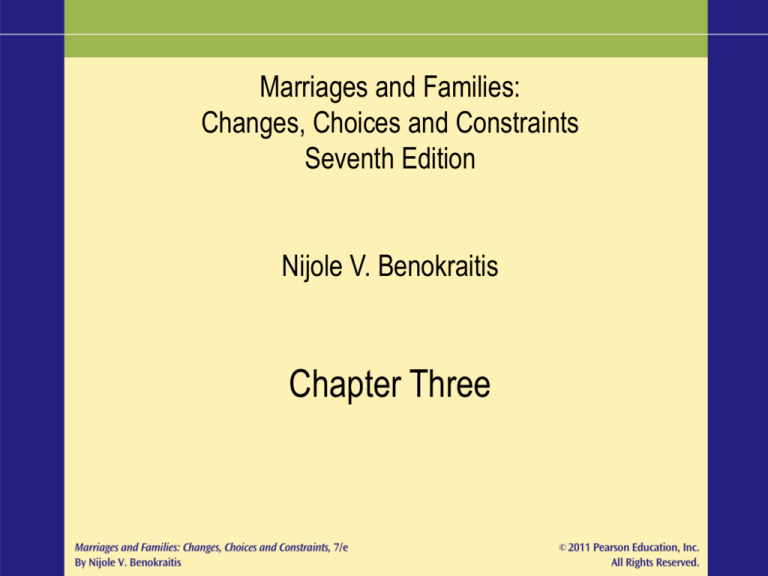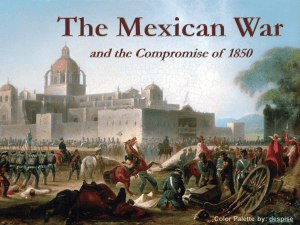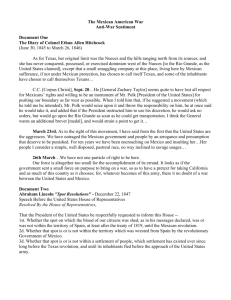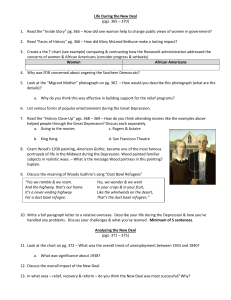Merchant Class - Flagler College
advertisement

Marriages and Families: Changes, Choices and Constraints Seventh Edition Nijole V. Benokraitis Chapter Three The Colonial Family How different were colonial families than families of today? They differed in social class, religious practices and geographic location, but they weren’t much different in family roles and family structures. The United States Family in History Were there really any “good old day” where life was simpler and less complicated? Social Scientists have been trying to determine if these eras actually existed for may people or for only an advantaged few. Did people really pull together after the Great Depression? Were the 1050s the golden era it is made to be in the mass media? Family Structure The nuclear family was the most common family form in both England and the United States in the early settlements. During these early years, few people survived outside families and most settlements were small. The family was a self sufficient business— members worked together to provide what they needed. The family provided schooling for children. The family provided a vocational institution. The family provided a church and many other functions that today are performed by other social institutions. Sexual Relations The puritans did not believe in premarital sex and tried to prevent it in several ways. However, many young women during this era were married and already pregnant. Adultery for women was considered immoral and illegal, while adultery for men was generally ignored, a double standard we still see today. Husbands and Wives Even though they had strong family relationships, women were still subordinate to me in relationships in early America. Few courts permitted divorce at the time, but for someone to get a divorce the charge had to be adultery, bigamy, desertion or impotence. Husbands and Wives Men were expected to look after the economic well being of the family and women were to provide a supporting role. Women generally did not own businesses, had little access to credit and were severely constrained in money matters. Children’s Lives Between 10 and 30 percent of all colonial children died before their first birthday. Children’s lives were dominated by the concepts Puritans believed that children were born with original sin and were inherently stubborn, willful, selfish and corrupt. The entire community worked together to keep children in their place. They were expected to be extraordinarily well behaved, obedient and docile. Social Class and Regional Differences There were different social classes in early America – In the Merchant Class, or upper class, the patriarchs typically were shipping and commercial entrepreneurs. – Highly skilled occupations, apprenticeship systems and cooperation among relatives characterized the artisan class or middle class. – The laboring class, or working class was made up of people who had no voting privileges and little education. Early American Families from Non-European Cultures American Indians - By the time that European settlers had arrived in American, there were almost 18 million Indians living in North America who spoke 300 different languages. American Indians were enormously diverse. – Family Structure-family structures and customs varied from one Indian Society to another – Polygamy was accepted in more than 20% of marriages in Indian communities. Early American Families from Non-European Cultures Approximately 25% of Native American Indian tribes were matrilineal, which means decent was traced through the mother’s line, not the father’s line. Despite our mainstream cultural beliefs about Native American Women, they held considerable power in their tribes. Early American Families from Non-European Cultures African Americans-The first African Americans were brought to this country as indentured servants. By the mid 1660’s the southern colonies had passed laws prohibiting blacks from testifying in court, owning property, making contract, legal marrying, traveling without permission etc… Early American Families from Non-European Cultures Slavery had begun in the “new world”. – While some plantation owners encouraged their slaves to marry and have large families, their motives were to sell off the children when they were old enough to be sold at a slave auction. Thus many families were disrupted by slavery. – There were many different ways of being “slave families”. Early American Families from Non-European Cultures In some slave families, men were very important as role models for the younger men. In other slave families, mothers were important because of their jobs of raising families, cooking meals, and taking care of the plantation owner’s children as well. Early American Families from Non-European Cultures Slavery was abolished in 1863, many families set out to reunite. Former slaves were allowed to have legal marriages and many African families moved north to escape the prejudice held against them in the south. Early American Families from Non-European Cultures Mexican Americans-After 30 years of war and conflict, in 1848 the United States annexed territory in the west and southwest that was originally part of Mexico. Most Mexicans became laborers. The loss of land was devastating to their culture. Mexican Americans Mexican laborers were essential to the prosperity of the southwestern businesses. Men and Women both worked outside the home for menial wages. They were known for hard work with little wages. Mexican Americans Mexican family life was characterized by Familism—that means that the family came before individual well being. – This is still practiced in some Latino communities today. – Women were the guardians of the family traditions even though many mothers worked outside the home because of economic concerns, Women nurtured Mexican culture thought folklore, song and other auspicious occasions. Mexican Americans Mexican men were usually the head of the households. Masculinity for these men was of the utmost importance. Industrialization Industrialization changed the American family in many ways. Gender became more contained in family roles I.e. men became the breadwinners and women stayed home to raise the children. This “domesticity” glorified women’s domestic roles—the world of the home became the world of the female. Men’s Roles By the early 1800s most middle and upper class men’s work was totally separated from ht e household with his being the struggle to “make a living”. This was when roles of men and women became very different. Children and Adolescents Father’s began to lose control over the lives of their children simply because they had fewer acres to divide among sons, so they had less power over who the son married. As for women, the percentage of women who were pregnant at the time of marriage shot up to 40% by the mid eighteenth century. Perhaps the biggest change, was that families started to view childhood as a discrete section of life and they treated children less as “miniature adults”. The Impact of Immigration and Urbanization Immigrants to the US provided a large pool of unskilled and semi-skilled labor that fueled emerging industries and gave investors huge profits. Immigrant families were certainly the poorest of the poor. Men and Women immigrants tended to move into specific jobs. The Impact of Immigration and Urbanization By 1890 all but 9 out of the 369 industries listed by the US Census Bureau employed women. By the late 1800s, Irish girls as young as 11 were leaving their homes to work as servants; 75% of all Irish teenage girls were domestic servants. Many were sexually assaulted by their male employers and not paid their agreed upon wage. The Impact of Immigration and Urbanization Most manufacturing jobs were segregated by sex. One of the biggest problem for immigrant families was the lack of decent housing in densely populated areas. The buildings were so tightly jammed together that the population of one tenement house was the same as the population of one entire town! Health Of course with such crowded conditions, came many health problems and disease. Cholera killed nearly 20% of a crowded New York neighborhood. The Modern Family Emerges Because of all of these changes happening in the United States, families changed as well. The “Companionate” family was born. The companionate family were ones that were build on sexual attraction, compatibility and personal happiness. Thus husbands and wives were not just economic units as they had been in the past, but the were dependent on each other for company and a sense of belonging. The Great Depression On October 29, 1929 the U.S. Stock Market crashed and the Great Depression began. By the mid 1930’s there were huge lay offs by manufacturers. The Great Depression affected every life in America. Often, men left their families in search of work, leaving the rest of the family with little or no resources. Many young women moved to cities to support their families. Women were more likely to be hired in factories where they were paid less. World War II After the US entered the war in 1941 families again saw huge changes in their structure and function. Millions of women went to work for the first time outside the home to fill in for jobs that men had to leave behind to fight in the war. Working class women were portrayed in very positive roles. Divorce Rates Divorce had been on the rise since 1940, but they increased dramatically at then end of the War. Some women found new economic independence and decided to end unhappy marriages. The Golden 50’s After WWII women were no longer welcome in the workplace because men were returning from the war and needed jobs. Movies and Television featured two stereotypical portrayals of women – Innocent Virgins such as Doris Day and Debbie Reynolds – Sexy Bombshells such as Marilyn Monroe and Jayne Mansfield The Baby Boomers The post WWII era produced a generation known as the Baby Boomers. Families plans that had been disrupted by the war were renewed and families were encouraged to have large families. There was also a rush to move to the suburbs and live away from central cities. Homeownership grew and construction of new homes skyrocketed. An Idyllic Decade? Were the 1950s really all we “remember” them to be or are those years largely a figment of our mass media? In fact, many families during the 50s still experienced severe racism. Child abuse and Domestic Violence were rampant during this decade—perhaps because people were recognizing the risks better. Open homosexuality was taboo. Many people even those “happy” housewives tried to escape their unhappy existences through alcohol and drugs. Families since the 1960s In the 70s families had lower birth rates and higher divorce rates compared with the 50s. Out of wedlock births especially to teen age mothers declined in the late 1990s and began to climb in 2006. Gender roles have changed dramatically since the 1950—women have much greater opportunities by going to college and having a career. Families, though are stressed by time constraints. Economic Impact The economy has had a huge impact on the family of the 21st century. Many older people who were retired had to return to work because their retirement portfolios shrank by at least 50% in some cases. Health costs are skyrocketing. Economic Impact The family has really experienced change rather than staying steady for the last 200 years or so. Many families have survived and thrived even though we are facing now one of the biggest economic crunches since the Great Depression. The American Family is GREAT at adaptation!





